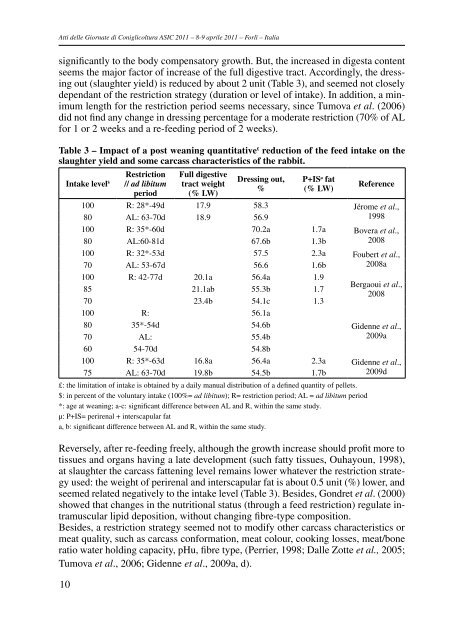atti delle giornate di coniglicoltura asic 2011 - Fondazione iniziative ...
atti delle giornate di coniglicoltura asic 2011 - Fondazione iniziative ...
atti delle giornate di coniglicoltura asic 2011 - Fondazione iniziative ...
You also want an ePaper? Increase the reach of your titles
YUMPU automatically turns print PDFs into web optimized ePapers that Google loves.
Atti <strong>delle</strong> Giornate <strong>di</strong> Coniglicoltura AsIC <strong>2011</strong> – 8-9 aprile <strong>2011</strong> – Forlì – Italia<br />
significantly to the body compensatory growth. but, the increased in <strong>di</strong>gesta content<br />
seems the major factor of increase of the full <strong>di</strong>gestive tract. accor<strong>di</strong>ngly, the dressing<br />
out (slaughter yield) is reduced by about 2 unit (Table 3), and seemed not closely<br />
dependant of the restriction strategy (duration or level of intake). in ad<strong>di</strong>tion, a minimum<br />
length for the restriction period seems necessary, since Tumova et al. (2006)<br />
<strong>di</strong>d not find any change in dressing percentage for a moderate restriction (70% of aL<br />
for 1 or 2 weeks and a re-fee<strong>di</strong>ng period of 2 weeks).<br />
Table 3 – Impact of a post weaning quantitative £ reduction of the feed intake on the<br />
slaughter yield and some carcass characteristics of the rabbit.<br />
10<br />
Intake level $<br />
Restriction<br />
// ad libitum<br />
period<br />
Full <strong>di</strong>gestive<br />
tract weight<br />
(% Lw)<br />
dressing out,<br />
%<br />
p+IS µ fat<br />
(% Lw)<br />
Reference<br />
100 r: 28*-49d 17.9 58.3 Jérome et al.,<br />
1998<br />
80 aL: 63-70d 18.9 56.9<br />
100 r: 35*-60d 70.2a 1.7a bovera et al.,<br />
2008<br />
80 aL:60-81d 67.6b 1.3b<br />
100 r: 32*-53d 57.5 2.3a Foubert et al.,<br />
2008a<br />
70 aL: 53-67d 56.6 1.6b<br />
100 r: 42-77d 20.1a 56.4a 1.9<br />
85 21.1ab 55.3b 1.7<br />
70 23.4b 54.1c 1.3<br />
100 r: 56.1a<br />
80 35*-54d 54.6b<br />
70 aL: 55.4b<br />
60 54-70d 54.8b<br />
bergaoui et al.,<br />
2008<br />
Gidenne et al.,<br />
2009a<br />
100 r: 35*-63d 16.8a 56.4a 2.3a Gidenne et al.,<br />
75 aL: 63-70d 19.8b 54.5b 1.7b 2009d<br />
£: the limitation of intake is obtained by a daily manual <strong>di</strong>stribution of a defined quantity of pellets.<br />
$: in percent of the voluntary intake (100%= ad libitum); r= restriction period; aL = ad libitum period<br />
*: age at weaning; a-c: significant <strong>di</strong>fference between aL and r, within the same study.<br />
µ: P+is= perirenal + interscapular fat<br />
a, b: significant <strong>di</strong>fference between aL and r, within the same study.<br />
reversely, after re-fee<strong>di</strong>ng freely, although the growth increase should profit more to<br />
tissues and organs having a late development (such fatty tissues, ouhayoun, 1998),<br />
at slaughter the carcass fattening level remains lower whatever the restriction strategy<br />
used: the weight of perirenal and interscapular fat is about 0.5 unit (%) lower, and<br />
seemed related negatively to the intake level (Table 3). besides, Gondret et al. (2000)<br />
showed that changes in the nutritional status (through a feed restriction) regulate intramuscular<br />
lipid deposition, without changing fibre-type composition.<br />
besides, a restriction strategy seemed not to mo<strong>di</strong>fy other carcass characteristics or<br />
meat quality, such as carcass conformation, meat colour, cooking losses, meat/bone<br />
ratio water hol<strong>di</strong>ng capacity, phu, fibre type, (Perrier, 1998; dalle Zotte et al., 2005;<br />
Tumova et al., 2006; Gidenne et al., 2009a, d).









